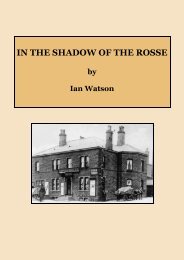You also want an ePaper? Increase the reach of your titles
YUMPU automatically turns print PDFs into web optimized ePapers that Google loves.
New Hirst Mill<br />
A n advertisement for New Hirst Mill, in the Leeds Intelligencer of 21st November<br />
1814, shows how the Esholt estate, under Joshua Crompton at this date, was prepared<br />
to accommodate a new tenant at the mill. The substance of it reads: ‘New Mill, to<br />
be let on lease, on the River Aire with a fall of near seven feet. The Mill is above fifty feet<br />
square and it is intended to add a chamber over the whole and to put in two water<br />
wheels eight feet broad, one to carry eight fulling stocks, and the other six scribbling engines,<br />
six carders, a willey, a Jiger and a teaser, large enough to supply six stubbing<br />
billies. If not let for woollen machinery it will be offered as a worsted, flax or other mill<br />
to the Tenant’s choice. Also available are two houses, two barns and about twenty acres<br />
of land near the mill’.<br />
It would seem that Joshua Crompton found a tenant but only for the fulling mill. A later<br />
advertisement in the Leeds Intelligencer of 18 th August 1817, (see page 27) shows him offering<br />
more inducements for the prospective tenant.<br />
Note: a) the emphasis on worsted or cotton machinery, rather than that for woollens; (b)<br />
the new wheel race, which can still be seen; (c) the five new cottages.<br />
A MEMORIAL of 1822 from the trustees of the estate of the late Cyril Jackson to John<br />
Wilmer Field of Heaton (who purchased the Manor of Shipley in 1823) lists all property<br />
comprising the Manor. Included is: ‘A newly erected mill used for the fulling of cloth<br />
with cottages lands and grounds at the north-west corner of Hirst Wood now in the occupation<br />
of Joshua Crompton Esq. under a lease (93 years unexpired) at the annual<br />
rent of five pounds’.<br />
Esholt Estate eventually found tenants for both departments of the mill. Parson and<br />
White’s Directory for 1830 gives for Shipley, New Hirst: ‘Davison & Co., Scribbling and<br />
Fulling Millers. Rayner, Joseph, Worsted Spinners’.<br />
In 1833, Parliament instigated a nationwide investigation into the employment of children<br />
in factories. Among those from whom The Factories Enquiry Commission took evidence<br />
about the Worsted side of the business was Joseph Rayner. Mr. Rayner’s response<br />
is here summarised:<br />
‘Mill used for Worsted Spinning since 1820. Driven by waterwheel. Ten horse power.<br />
Employs 35 persons, plus warehouse and counting house staff. Hours of work: 72<br />
hours per week of six days. The mill starts at 6 a.m., stops for one hour for lunch at<br />
noon, works 9 ½ hours on Saturday and 12½ hours on the other five days.<br />
Holidays: Five days regular holiday per year paid.<br />
Conditions: There are no fines or punishments. Children under 12 yrs. are employed in<br />
spinning or piecing only’.<br />
Ages and pay in a regular week of 72 hours:<br />
Males Females Age in Yrs. Wages per week<br />
6 4 under 10 3s.<br />
2 3 10 to 12 3s. 6d.<br />
4 12 to 14 4s. 6d.<br />
3 4 14 to 16 5s. 6d.<br />
3 16 to 18 6s.<br />
2 18 to 21 6s<br />
3 1 over 21 16s. 6d for males<br />
7s for females<br />
N.B. nearly a third of Rayner’s employees are children under 10 years old.<br />
19



